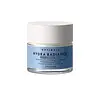What's inside
What's inside
 Key Ingredients
Key Ingredients

 Benefits
Benefits

 Concerns
Concerns

 Ingredients Side-by-side
Ingredients Side-by-side

Water
Skin ConditioningDimethicone
EmollientGlycerin
HumectantHydrogenated Polyisobutene
EmollientAlcohol Denat.
AntimicrobialButylene Glycol
HumectantGlyceryl Stearate
EmollientSalicylic Acid
MaskingAmmonium Polyacryloyldimethyl Taurate
Emulsion StabilisingIsopropyl Lauroyl Sarcosinate
Skin ConditioningOctyldodecanol
EmollientAcrylonitrile/Methyl Methacrylate/Vinylidene Chloride Copolymer
Capryloyl Glycine
CleansingCapryloyl Salicylic Acid
ExfoliatingDimethicone/Vinyl Dimethicone Crosspolymer
Skin ConditioningDisodium EDTA
PEG-100 Stearate
Perlite
AbsorbentPhenylethyl Resorcinol
AntioxidantPoloxamer 338
EmulsifyingSilica
AbrasiveSilica Silylate
EmollientSodium Hydroxide
BufferingSodium Polyacrylate
AbsorbentStearyl Alcohol
EmollientXanthan Gum
EmulsifyingZinc PCA
HumectantParfum
MaskingWater, Dimethicone, Glycerin, Hydrogenated Polyisobutene, Alcohol Denat., Butylene Glycol, Glyceryl Stearate, Salicylic Acid, Ammonium Polyacryloyldimethyl Taurate, Isopropyl Lauroyl Sarcosinate, Octyldodecanol, Acrylonitrile/Methyl Methacrylate/Vinylidene Chloride Copolymer, Capryloyl Glycine, Capryloyl Salicylic Acid, Dimethicone/Vinyl Dimethicone Crosspolymer, Disodium EDTA, PEG-100 Stearate, Perlite, Phenylethyl Resorcinol, Poloxamer 338, Silica, Silica Silylate, Sodium Hydroxide, Sodium Polyacrylate, Stearyl Alcohol, Xanthan Gum, Zinc PCA, Parfum
Water
Skin ConditioningGlycerin
HumectantHydrogenated Polydecene
EmollientAluminum Starch Octenylsuccinate
AbsorbentBetaine
HumectantTriethylhexanoin
MaskingCyclopentasiloxane
EmollientCyclohexasiloxane
EmollientButyrospermum Parkii Butter
Skin ConditioningCetyl Alcohol
EmollientGlyceryl Stearate
EmollientPEG-100 Stearate
Stearyl Alcohol
EmollientPhenoxyethanol
PreservativeAmmonium Acryloyldimethyltaurate/Vp Copolymer
Imidazolidinyl Urea
PreservativeCaprylyl Glycol
EmollientStearic Acid
CleansingPalmitic Acid
EmollientXanthan Gum
EmulsifyingNiacinamide
SmoothingSodium Starch Octenylsuccinate
AbsorbentCalcium Pantothenate
Maltodextrin
AbsorbentBiosaccharide Gum-4
Skin ConditioningCalluna Vulgaris Flower Extract
Skin ConditioningCastanea Sativa Seed Extract
Skin ConditioningSodium Ascorbyl Phosphate
AntioxidantArachidic Acid
CleansingLauric Acid
CleansingMyristic Acid
CleansingPyridoxine Hcl
Skin ConditioningTocopheryl Acetate
AntioxidantPotassium Sorbate
PreservativeSodium Benzoate
MaskingSilica
AbrasiveWater, Glycerin, Hydrogenated Polydecene, Aluminum Starch Octenylsuccinate, Betaine, Triethylhexanoin, Cyclopentasiloxane, Cyclohexasiloxane, Butyrospermum Parkii Butter, Cetyl Alcohol, Glyceryl Stearate, PEG-100 Stearate, Stearyl Alcohol, Phenoxyethanol, Ammonium Acryloyldimethyltaurate/Vp Copolymer, Imidazolidinyl Urea, Caprylyl Glycol, Stearic Acid, Palmitic Acid, Xanthan Gum, Niacinamide, Sodium Starch Octenylsuccinate, Calcium Pantothenate, Maltodextrin, Biosaccharide Gum-4, Calluna Vulgaris Flower Extract, Castanea Sativa Seed Extract, Sodium Ascorbyl Phosphate, Arachidic Acid, Lauric Acid, Myristic Acid, Pyridoxine Hcl, Tocopheryl Acetate, Potassium Sorbate, Sodium Benzoate, Silica
 Reviews
Reviews

Ingredients Explained
These ingredients are found in both products.
Ingredients higher up in an ingredient list are typically present in a larger amount.
Glycerin is already naturally found in your skin. It helps moisturize and protect your skin.
A study from 2016 found glycerin to be more effective as a humectant than AHAs and hyaluronic acid.
As a humectant, it helps the skin stay hydrated by pulling moisture to your skin. The low molecular weight of glycerin allows it to pull moisture into the deeper layers of your skin.
Hydrated skin improves your skin barrier; Your skin barrier helps protect against irritants and bacteria.
Glycerin has also been found to have antimicrobial and antiviral properties. Due to these properties, glycerin is often used in wound and burn treatments.
In cosmetics, glycerin is usually derived from plants such as soybean or palm. However, it can also be sourced from animals, such as tallow or animal fat.
This ingredient is organic, colorless, odorless, and non-toxic.
Glycerin is the name for this ingredient in American English. British English uses Glycerol/Glycerine.
Learn more about GlycerinGlyceryl Stearate is a mix of glycerin and stearic acid.
It is used to stabilize the mixing of water and oil ingredients. By preventing these ingredients from separating, it can help elongate shelf life. It can also help thicken the product's texture.
As an emollient, it helps soften skin and supports barrier-replenishing ingredients.
In cosmetics, Glyceryl Stearate is often made from vegetable oils or synthetically produced.
This ingredient may not be fungal-acne safe
Fun fact: The human body also creates Glyceryl Stearate naturally.
Learn more about Glyceryl StearatePeg-100 Stearate is an emollient and emulsifier. As an emollient, it helps keep skin soft by trapping moisture in. On the other hand, emulsifiers help prevent oil and water from separating in a product.
PEGS are a hydrophilic polyether compound . There are 100 ethylene oxide monomers in Peg-100 Stearate. Peg-100 Stearate is polyethylene glycol ester of stearic acid.
Silica, also known as silicon dioxide, is a naturally occurring mineral. It is used as a fine, spherical, and porous powder in cosmetics.
Though it has exfoliant properties, the function of silica varies depending on the product.
The unique structure of silica enhances the spreadability and adds smoothness, making it a great texture enhancer.
It is also used as an active carrier, emulsifier, and mattifier due to its ability to absorb excess oil.
In some products, tiny microneedles called spicules are made from silica or hydrolyzed sponge. When you rub them in, they lightly polish away dead skin layers and enhance the penetration of active ingredients.
Learn more about SilicaStearyl Alcohol is a type of fatty alcohol from stearic acid. It is a white, waxy compound used to emulsify ingredients.
Fatty Alcohols are most often used as an emollient or to thicken a product. Emollients help soothe and hydrate the skin by trapping moisture.
They are usually derived from natural fats and oils and therefore do not have the same drying or irritating effect as solvent alcohols. FDA allows products labeled "alcohol-free" to have fatty alcohols.
Learn more about Stearyl AlcoholWater. It's the most common cosmetic ingredient of all. You'll usually see it at the top of ingredient lists, meaning that it makes up the largest part of the product.
So why is it so popular? Water most often acts as a solvent - this means that it helps dissolve other ingredients into the formulation.
You'll also recognize water as that liquid we all need to stay alive. If you see this, drink a glass of water. Stay hydrated!
Learn more about WaterXanthan gum is used as a stabilizer and thickener within cosmetic products. It helps give products a sticky, thick feeling - preventing them from being too runny.
On the technical side of things, xanthan gum is a polysaccharide - a combination consisting of multiple sugar molecules bonded together.
Xanthan gum is a pretty common and great ingredient. It is a natural, non-toxic, non-irritating ingredient that is also commonly used in food products.
Learn more about Xanthan Gum